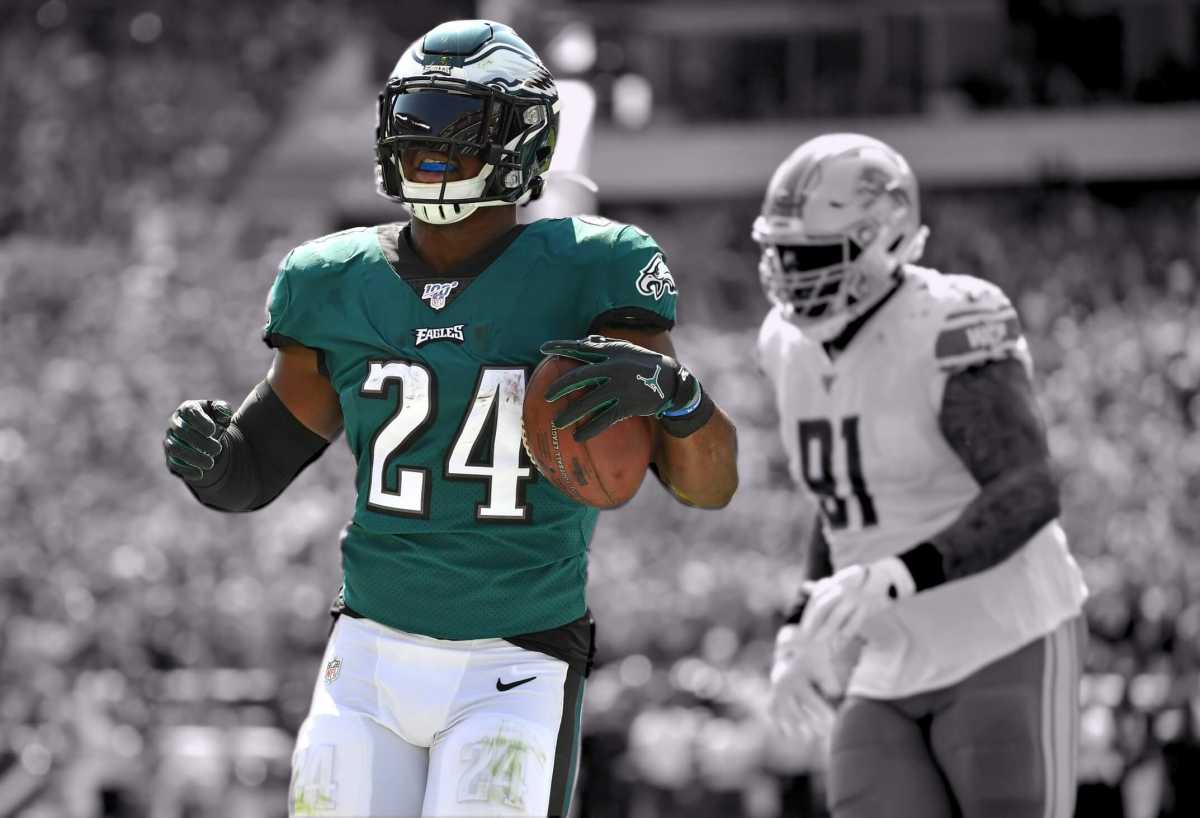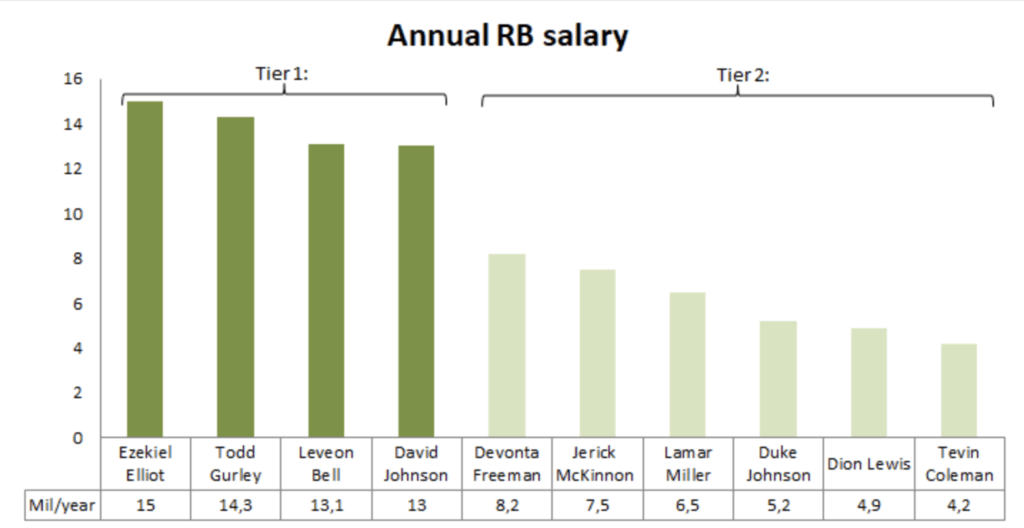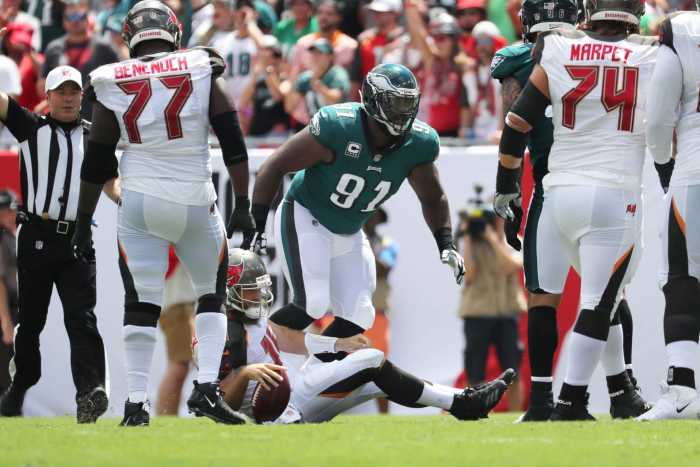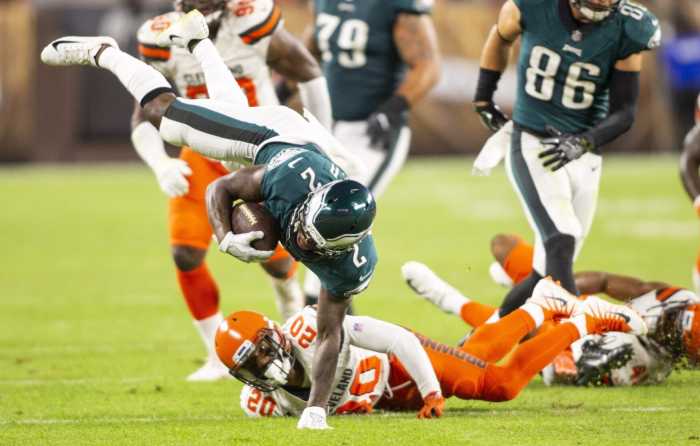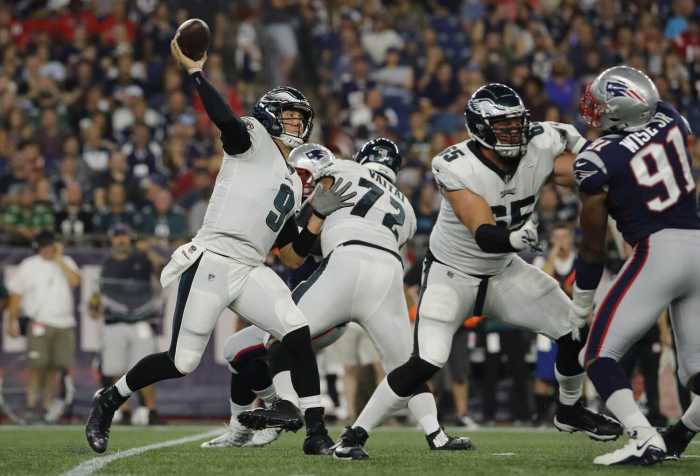Jordan Howard is emerging as one of the best players on offense for the Eagles and after consistently moving the chains through the opening five games of the season, the world is beginning to wonder one thing: Should the Eagles extend him, and if so, what would it cost?
In 5 weeks, Howard has accumulated 248 rushing yards, 4,7 yards/carry, 6 catches for 47 yards, and 5 total TDs. But as productive as he’s been, he’s also in his final contracted year, meaning there will be a tasty free-agent market waiting for him come season’s end.
But let’s get down to the nitty-gritty.
Setting the field of comparison
First off, let’s look into the salaries of relevant RBs in the same tier of Jordan Howard. To compare, Howard will be 25 years old in November, has rushed for an average of 1,123 yards/season, 8 TDs/year, and 4.4 yards/carry in his career. Let’s divide the field into tiers, excluding rookie RBs contracts:
Tier 1:
- Ezekiel Elliot: 24 years old, the heart and soul of the Cowboys offense.
- Todd Gurley: Signed as 23- year old after carrying the Rams.
- Le’Veon Bell: 27-year old, averaged 1,600 scrimmage yards per season in 5 years with Steelers. Arguably most dynamic RB in the league.
- David Johnson: Signed as 26-year old prior to 2018 season, after leading the league with 2.118 scrimmage yards and 20 TDs in 2016.
Tier 2:
- Devonta Freeman: Signed at 25-years old in 2017 after amassing 3,175 scrimmage yards and 27 TDs between 2015 and 2016.
- Jerick McKinnon: Signed as a 25-year-old in 2018, was a productive, talented backup with Vikings.
- Lamar Miller: Signed in 2016 at 25, had minimum 1,250+ yards and 9.5 TDs in 2014 and 2015 with Dolphins.
- Duke Johnson: Signed in 2018 at 24, was the top receiving RB in the league, averaged around 6.8 yards/touch in 2016 and 2017.
- Tevin Coleman: 26 years old, signed in 2019 after averaging 900+ yards, 5,6 yards/touch, and 9,5 TDs from 2016-2018.
Average salary divided into RB tiers
Using contract details from OverTheCap.com, the salary per year divided into tiers look like this:
There is a huge difference between the salaries in tier 1, primarily because at the time they signed their contracts, they were among the most dominant players in the league. After that, despite putting up ridiculous numbers, tier 2 RBs slip fast into an average salary of 6 million/year.
Upcoming free agent RBs
| Player | Age |
| Melvin Gordon | 26 |
| Derrick Henry | 25 |
| Lamar Miller | 28 |
| Kareem Hunt | 24 |
| Matt Breida | 24 |
| Chris Thompson | 29 |
| Carlos Hyde | 28 |
When there are other good players going into free agency, it can do 2 things:
1) The price for Howard can go up if the average price is generally elevated.
2) The price for Howard can go down if there are too many other good options, so Howard becomes “just another guy”.
The list for 2020 free agency features some really intriguing, young, dynamic players. However, as we saw with Melvin Gordon, getting a contract extension as a RB is tough, as suddenly there are guys like Austin Ekeler stepping up, which is in part why RB’s usually don’t have good leverage in contract talks and why the Bears were so swift in parting ways with one of the most productive backs in the league one year early, only to draft a Jordan Howard 2.0.
Jordan Howard: 4-years, $28 million, 7 mil/year. Why?
Howard’s resume puts him in the middle of my tier 2. I put him under Devonta Freeman and Jerick McKinnon, push with Lamar Miller, and above Duke, Dion, and Coleman.
– At the time Devonta Freeman signed his contract, he was simply dominant as a runner and receiver.
– Jerick McKinnon was kind of like what Josh Jacobs was for Alabama: super talented backup who the 49ers banked on to become legit as a starter – unfortunately, he tore his ACL…twice…
Lamar Miller’s situation in 2016 is the perfect comparison for Howard:
- They were/are both 25 years old at the time of a new contract.
- Miller was a 4th round pick, Howard was a 5th.
- Prior to his contract, Miller averaged almost the same amount of scrimmage yards and TDs in his last 2 years with the Dolphins as Howard did in his last 3 years with Bears.
The RB marked got a boost since Miller signed at 6.5 mil/year in 2016, as Zeke, Gordon, Bell, and Johnson were signed since. Hence, I boosted the average to 7 mil/year.
4 years would guarantee Howard safety throughout most of his career, whereas 3 years would require him to rely on a new contract in 2022 again. The Eagles might want to limit it to 3 years, $21 million, however, so the idea here would be that Miles Sanders fully takes over as an RB1 in 2023. However, that’s where things could get murky.
Sanders’ rookie contract is up in 2022 and it’s clear that the plan was for Sanders to one day take over the reins in this backfield. The Penn State graduate has plenty of upside and the Eagles spent a second-round pick to secure his services. Would enforcing a roadblock in front of him for the remainder of his rookie deal come back to haunt the Eagles?
It’s too early to say, but it’s also too early to assume that Sanders is ready to step up as LeSean McCoy did in his second season, where he carried the ball 207 times. Sanders’ skillset lends itself to being a dual-threat back, so the touches may soon add up, but the question here isn’t can the Eagles afford to keep Jordan Howard…
It’s can they afford life without him?

